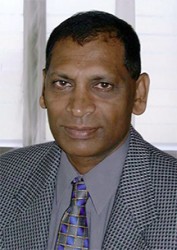Agriculture Minister, Dr Leslie Ramsammy yesterday denied drug lords were the major investors in Guyana’s development and instead said that small scale rice farmers were actually the largest investors domestically.
Dr Ramsammy said that in operational costs alone rice farmers spent $28 billion last year, “not in in-kind contributions, not in their investments in machines, but in operational costs, in real money, directly for cultivation. This is money they invested in land preparations, in fertilizers and pesticides, in seed paddy, in water management in their fields, in harvesting, in transportation of their paddies.”
He said that rice farmers also spent $6 billion in tractors and harvesters, adding that in 2014 farmers were likely to spend $2 billion more on equipment.

Dr Ramsammy stated that rice millers would have spent $10b to increase drying, storing and milling in the past four years while rice exports amounted to more than US$240 million in export earnings in 2013.
The agriculture minister stated that with the expansion of the sector the 2014 budget was focused on supporting rice and that the proposed $500 million allocation was far from a “hand-out to farmers.”
Dr Ramsammy said that $70 million will be spent to operationalise a seed facility and to introduce a larger storage facility for the industry. He said that Regions 2, 3, 4, 5 and 6 will also receive laser levels which will help reduce the amount of water needed for the field, but did not state when these would be procured or how much this would cost.
He said that last year’s rice production of 535,000 tonnes could increase this year to 600,000 tonnes and that proper field care and research was working to better the industry.
His attention turned to the sugar industry where he revealed that of the $6 billion proposed in the budget, “land conversion costs will account for $1.1Bn with 2,500 ha of land slated to be converted in 2014. Another $1B will be expended on the tillage and replanting programme this year with 9,600 ha of land to be tilled and 9,224 ha to be planted.”
Dr Ramsammy mentioned that investment in flood fallowing would also be considered in 2014, along with various capital projects and of course mechanisation.
“A portion of the $6B will be spent on capital programmes in our factories. These programmes include replacing old and outdated pumps, improvement of factory automation at Albion, works on the two punt dumpers at Skeldon and the upgrade of boilers at Uitvlugt,” the agriculture minister said. Ramsammy did not explain why additional money would be spent on the Skeldon punt dumps when in 2013 the South African company, Bosch Engineering was awarded a multimillion dollar contract that was inclusive of rehabilitation of the punt dumps.
He said that the Guyana Sugar Corporation had already appointed a new Board of Directors although there has yet to be a formal and public announcement considering the life of the current GuySuCo board which expired at the beginning of 2014.
Dr Ramsammy stated that the sector was more than just rice and sugar and that growth in food production was definitely the direction in which Guyana’s agriculture sector needed to be heading.
Guyana spends over US$150 million annually on food imports, “while Guyana’s Food Import Bill of $US200 per capita is on the lower side for CARICOM countries, this is unacceptable,” Dr Ramsammy stated, adding, “the high food import bill, almost $US200 per capita, is not necessary. For this reason we must do a better job of marketing our local food.”
In 2014 the growing of corn will be on a commercial scale while a proper production information system will be further developed. Dr Ramsammy stated that Guyana currently produced more than $30 billion worth of vegetables and other food products but the lack of a proper production information system means that this amount could be closer to $50 billion.
He said that an agro-development bank and crop insurance were measures that were still on the table in 2014. Members of the opposition did heckle the minister when he pointed out that these two issues have been spoken about since before he was minister. Dr Ramsammy countered that “these are mechanisms that can prove significant in our development and if we are serious about agriculture as a main pillar of our development, these initiatives should be studied with a high degree of seriousness. As we implement the Agriculture Strategy, the Ministry of Agriculture intends to submit our recommendations as a way forward to Cabinet during 2014.”
He said that research and development in 2013 have assisted with the establishment of an agro-meteorology sector. He revealed that the section will be responsible for the weekly publication of crop specific forecasts as well as a three-month rainfall and dry season prediction for relevant sectors such as the rice and sugar industries.




